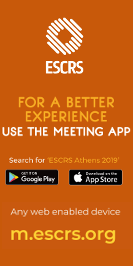Biomechanical properties of human cornea tested by two-dimensional extensiometry ex vivo in fellow eyes: femtosecond laser-assisted LASIK vs SMILE
(results will display both Free Papers & Poster)
Session Details
Session Title: Refractive
Session Date/Time: Friday 15/02/2019 | 08:30-10:00
Paper Time: 09:10
Venue: Room MC3
First Author: B.Spiru GERMANY
Co Author(s): S. Kling F. Hafezi W. Sekundo
Abstract Details
Purpose:
To investigate the biomechanical properties of the ex vivo human cornea after flap-based versus cap-based laser refractive surgery in the same donor.
Setting:
In this experimental study, 11 pairs of human corneas unsuitable for transplantation were equally divided into two groups. Corneas from the right eye were treated with femtosecond laser–assisted LASIK (fs-LASIK) and corneas from the left eye with small incision lenticule extraction (SMILE).
Methods:
Pachymetry was measured in each eye directly before laser refractive surgery. All corneas were subjected to a refractive correction of -10.00 diopters (D) sphere and -0.75 D cylinder at 0° with a 7-mm zone, using either a 110-μm flap (FS-LASIK) or
130-μm cap (SMILE). For two-dimensional biomechanical measurements, corneoscleral buttons underwent two testing cycles (preconditioning stress-strain curve from 0.03 to 9.0 N and stress-relaxation at 9.0 N during 120 sec) to analyze the elastic and viscoelastic material properties. The effective elastic modulus was calculated. Statistical analysis was performed with a confidence interval
of 95%.
Results:
In stress-strain measurements, the effective elastic modulus was 1.47 times higher (P = .003) after SMILE (median = 8.22 [interquartile range = 4.76] MPa) compared to FS-LASIK (median = 5.59 [interquartile range = 2.77] MPa). The effect size was large
(r = 0.83). No significant differences (P = .658) were observed among stress-relaxation measurements, with a mean remaining stress of 181 ± 31 kPa after SMILE and 177 ± 26 kPa after FS-LASIK after relaxation.
Conclusions:
Compared to a flap-based procedure such as FS-LASIK, the SMILE technique can be considered superior in terms of biomechanical stability, when measured experimentally in ex vivo human fellow eye corneas.
Financial Disclosure:
... receives consulting fees, retainer, or contract payments from a company producing, developing or supplying the product or procedure presented



